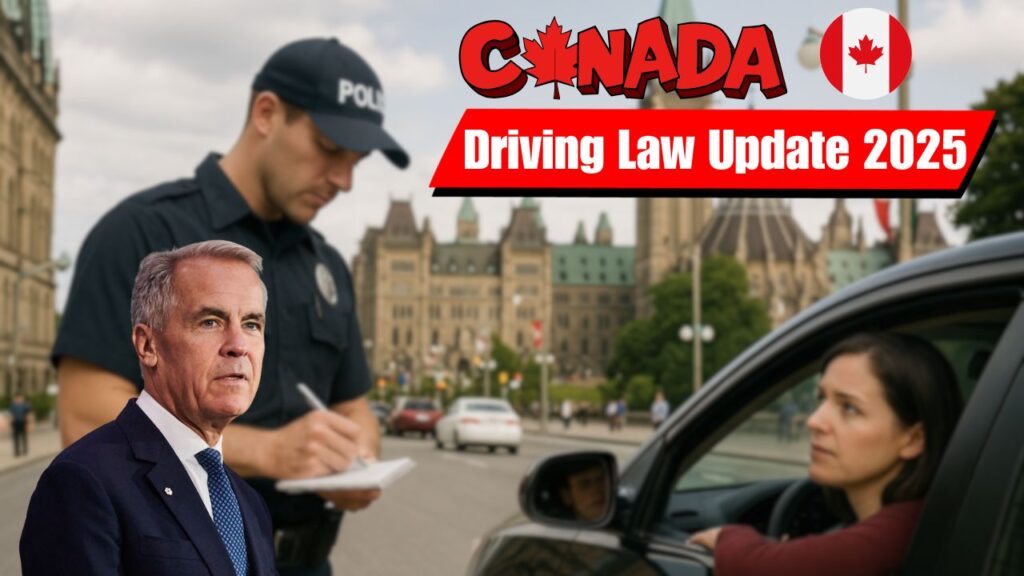In 2025, Canada has introduced significant updates to its driving regulations to improve road safety and discipline among motorists. The new Canada Driving Law 2025 enforces stricter penalties for reckless behavior and distracted driving, with fines reaching up to $1,000 for certain violations. These changes aim to reduce accidents, promote responsible driving, and ensure safer roads for everyone. Canadian drivers are encouraged to stay informed about new safety rules, compliance requirements, and updated enforcement measures across all provinces.

New Safety Regulations Under the Canada Driving Law 2025
The Canada Driving Law update emphasizes safety-first driving habits by tightening penalties for high-risk activities such as using mobile phones while driving, tailgating, and speeding in school zones. Authorities have mandated the installation of advanced vehicle safety features in new cars, including lane assist and emergency braking systems. Additionally, provinces like Ontario and British Columbia are now enforcing zero-tolerance policies for distracted driving. Motorists must also adhere to stricter seatbelt and child restraint rules, with failure to comply resulting in immediate license suspension or fines up to $1,000.
Fines and Penalties for Common Violations
Under the revised laws, the Canadian government has set a new fine structure that penalizes offenses based on severity. Violations such as texting while driving can now lead to immediate fines and demerit points, while serious reckless driving incidents could lead to temporary suspension or court appearances. Drivers found under the influence of alcohol or drugs face license cancellation and mandatory education programs. Moreover, speeding fines have been increased across most provinces to discourage aggressive driving, particularly near pedestrian zones and school areas.
 Canada CRA Dept. Confirms 2025 Payment Schedule – Date Calendar for All Monthly Benefits and Rebates
Canada CRA Dept. Confirms 2025 Payment Schedule – Date Calendar for All Monthly Benefits and Rebates
How Provinces Are Implementing the New Rules
Each Canadian province is tailoring the new driving law framework to suit local conditions and enforcement capabilities. For example, Quebec has introduced advanced roadside cameras to monitor driver compliance, while Alberta focuses on awareness programs through community campaigns. The federal government supports these initiatives by providing road safety grants for technology upgrades and driver training programs. These collective measures are expected to make Canadian roads safer and reduce the number of collisions by encouraging consistent adherence to traffic rules nationwide.
Key Overview of Fines and Enforcement Details
To help citizens better understand the recent driving law changes, the table below summarizes the major violations and their corresponding penalties as enforced in 2025. Every driver should familiarize themselves with these updates to avoid unnecessary fines and ensure safe driving practices under the new national framework.
| Violation Type | Fine Amount | Demerit Points | Additional Consequence |
|---|---|---|---|
| Distracted Driving (Mobile Use) | $600 – $1,000 | 3 | License Suspension (Repeat Offense) |
| Speeding in School Zones | $400 – $800 | 4 | Mandatory Safety Course |
| Driving Without Seatbelt | $250 – $500 | 2 | Warning and Fine |
| Driving Under Influence | $1,000+ | 6 | License Cancellation |
| Reckless or Aggressive Driving | $750 – $1,000 | 5 | Court Summon Possible |
FAQ
1: When did the new Canada Driving Law take effect?
The updated driving laws officially came into effect in January 2025.
2: What is the maximum fine under the new law?
Drivers can face up to $1,000 fine for serious violations like reckless or distracted driving.
3: Are senior drivers affected by these changes?
Yes, senior motorists must follow enhanced medical and vision test requirements in 2025.
4: Do these laws apply nationwide?
Yes, all Canadian provinces follow the federal guidelines, with minor provincial variations.




